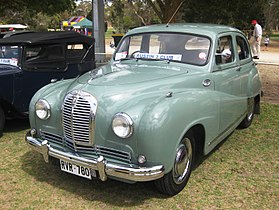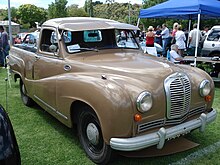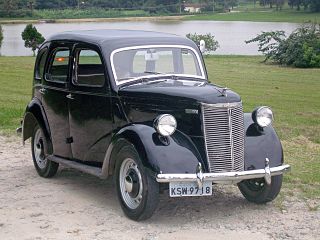
The Ford Prefect is a line of British cars which was produced by Ford UK between 1938 and 1961 as an upmarket version of the Ford Popular and Ford Anglia small family cars. It was introduced in October 1938 and remained in production until 1941. Returning to the market in 1945, it was offered until 1961. The car progressed in 1953 from its original perpendicular or "sit-up-and-beg" style to a more modern three-box structure. Some versions were also built and sold by Ford Australia.
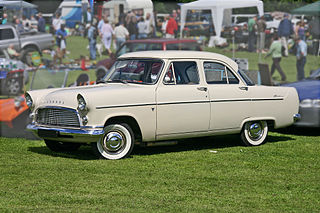
The Ford Consul is a car that was manufactured by Ford of Britain from 1951 until 1962. The name was later revived for a model produced by Ford in both the UK and in Germany from 1972 until 1975.

The Morris Minor is an economy car produced by British marque Morris Motors between 1948 and 1971. It made its debut at the Earls Court Motor Show, London, in October 1948. Designed under the leadership of Alec Issigonis, more than 1.6 million were manufactured in three series: the Series MM, the Series II, and the 1000 series.
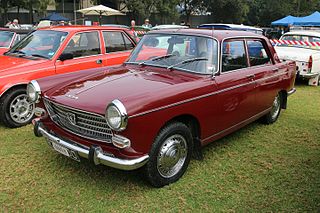
The Peugeot 404 is a large family car produced by French automobile manufacturer Peugeot from 1960 to 1975. A truck body style variant was marketed until 1988. Styled by Pininfarina, the 404 was offered initially as a saloon, estate, and pickup. A convertible was added in 1962, and a coupé in 1963. The 404 was fitted with a 1.6 litre petrol engine, with either a Solex carburetor or Kugelfischer mechanical fuel injection or a 1.9 litre diesel engine available as options. Introduced at the Paris Motor Show as an option was the inclusion of a 3-speed ZF automatic transmission, similar to the unit already offered on certain BMW models, as an alternative to the standard column-mounted manual unit.

The Austin A90 Atlantic is a British car produced by the Austin Motor Company from 1949 until 1952. It was launched initially as a four-seat convertible, making its début at the 1948 Earls Court Motor Show in London, with production models built between early 1949 and late 1950. A two-door coupé, marketed as the A90 Atlantic sports saloon, followed a year later. It had been previewed at the 1949 Motor Show and was in production at Longbridge between 1950 and 1952.

The Austin A30 is a small family car produced by Austin from May 1952 to September 1956. It was launched at the 1951 Earls Court Motor Show as the "New Austin Seven" and was Austin's competitor with the Morris Minor.
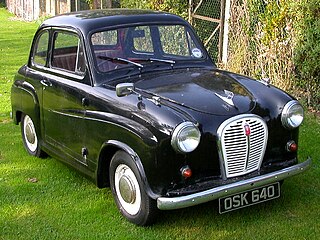
The Austin A35 is a small family car that was sold by Austin from 1956 until 1968. About 280,897 A35s of all types were produced.

The Austin A40 Farina is a small, economy car introduced by Austin in saloon (1958) and A40 Countryman (1959) estate versions. It has a two-box body configuration. It was badged, like many before it, as an A40, consistent with Austin's naming scheme at the time, based on the approximate engine output in horsepower; and to distinguish it from other A40 models, it was also given a suffix name – this one being the Farina, reflecting the all-new design by Italian Battista Farina's Pinin Farina Turin studio.

The A40 Devon are automobiles that were marketed by Austin from 1947 to 1952 – the first post-war saloons to be produced by Austin – featuring a mix of old and new technologies. They were previewed by the UK press at the Paris Motor Show on 22 October 1947, who expressed immediate disappointment at the car's conservative appearance. More than 450,000 were built before the model's replacement in 1952 by the Austin A40 Somerset.

The Austin A40 Sports debuted at the 1949 London Motor Show at Earls Court as a four-passenger, aluminium-bodied convertible variant of the Austin A40 – carrying an Austin of England nameplate, bearing Austin's Flying A hood ornament, and designed and manufactured in conjunction with Jensen Motors.

The Austin A40 Somerset is a motor car which was produced by the Austin Motor Company from 1952 until 1954. The Somerset replaced the Austin A40 Devon and, as a body-on-frame car, it was comparable in size to its predecessor. It shared a number of components with the Devon which included a similar 1.2 litre straight-4 pushrod engine. The Somerset's engine was updated to produce 42 hp (31 kW), compared to the Devon's 40 hp (30 kW), giving the car a top speed of 70 mph (110 km/h).

The Austin Cambridge is a medium-sized motor car range produced by the Austin Motor Company, in several generations, from September 1954 through to 1971 as cars and to 1973 as light commercials. It replaced the A40 Somerset and was entirely new, with modern unibody construction. The range had two basic body styles with the A40, A50, and early A55 using a traditional rounded shape and later A55 Mark IIs and A60s using Pininfarina styling.

The MG Magnette is an automobile that was produced by MG between 1953 and 1968. The Magnette was manufactured in two build series, the ZA and ZB of 1953 through to 1958 and the Mark III and Mark IV of 1959 through to 1968, both using a modified Wolseley body and an Austin engine.

The Wolseley 15/60 is an automobile which was produced from 1958 to 1961, and then, as the Wolseley 16/60, from 1961 to 1971. The 15/60 was the first of the mid-sized Pinin Farina-styled automobiles manufactured by the British Motor Corporation (BMC). Launched in December 1958 as part of BMC's Wolseley brand, the design would eventually be shared with seven other marques. All of the cars were updated in 1961 with a larger engine and new model designations. The Wolseley 16/60 was the last, in production until 24 April 1971.

The Austin Westminster series are large saloon and estate cars that were sold by the British manufacturer Austin from 1954, replacing the A70 Hereford. The Westminster line was produced as the A90, A95, A99, A105, and A110 until 1968 when the new Austin 3-Litre took its place. Essentially badge-engineered versions of the Farina Westminsters were also produced using the premium Wolseley and Vanden Plas marques. 101,634 Westminsters were built.

The Bentley Mark VI is an automobile from Bentley which was produced from 1946 until 1952.
Morris Cowley was a name given to various cars produced by Morris from 1915 to 1958.

The Standard Vanguard is a car which was produced by the Standard Motor Company in Coventry, England, from 1947 until 1963.
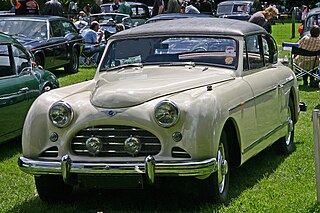
The Jensen Interceptor made its debut in 1950 as the second car made by Jensen Motors after World War II. The car was based on Austin components with a body built by Jensen and styled by Eric Neale. The 3,993 cc straight-six engine and transmission came from the Austin Sheerline and the chassis was a lengthened version of the one used on the Austin A70 with a modified version of the independent coil sprung suspension.

Morris Oxford Series MO is an automobile produced by Morris Motors of the United Kingdom from 1948 to 1954. It was one of several models to carry the Morris Oxford name between 1913 and 1971.




